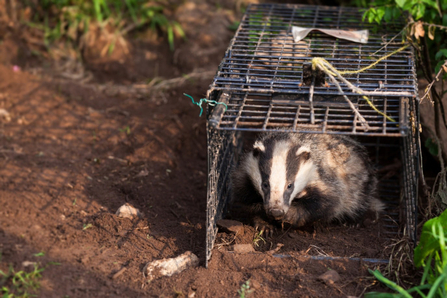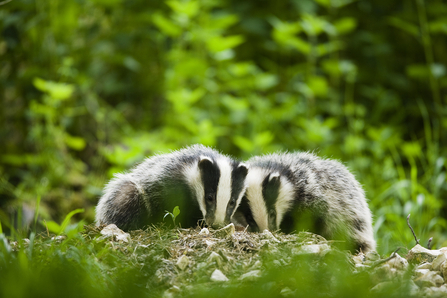GWT was the first charity in the country to test the roll out of badger vaccination and our trial ran between 2011 and 2015. Our report at the end of that trial concluded badger vaccination had been under-used in the fight against Bovine TB and that we need to work with farmers on solutions that should include vaccinating badgers and cattle. Cheryl talks about the importance of the consultation and the role that solutions like badger vaccination might play in the future.
What do the latest Defra bTB proposals mean for farmers, cattle and badgers?

Badger release Seth Jackson
Words from Cheryl Marriott, Cornwall Wildlife Trust
The answer may depend on A) where you are in the country and B) your primary motivation for being interested, controlling disease in cattle or protecting badgers from culling.
What qualifies a nature conservationist from Cornwall to comment? It’s a fair question.
I have been listening to, and learning from, local farmers, vets, and scientists for several years now in the Cornwall TB Eradication Group, trying to avoid unconstructive arguments and find common ground. This is my interpretation of the implications of the latest consultation. Any errors or misrepresentations are unintentional. The more I learn the more I see what a wicked problem bovine TB is. It also becomes ever clear to me that further polarisation of opinion is unlikely to help.
One aspect of the consultation that I hope most people will support is the government’s commitment to developing a cattle vaccine for TB. On the surface this seems a no-brainer, but there are several hurdles that need to be overcome and there is no guarantee of success. Still, field trials will start this year, so a deployable cattle vaccine is a step closer, which must be a good thing.
The consultation also seeks views on changes to cattle TB testing regimes. One proposal is to extend post-movement testing to parts of the ‘Edge area’ (A north-south line of central England counties dividing the High Risk Area (HRA) to the west and the Low Risk Area (LRA) to the east). Under the plans, cattle moved from higher risk areas of Britain into those parts of the Edge area where cattle are only tested annually, will need a post-movement TB test. This will have cost implications for farmers but should help to reduce new TB outbreaks caused by cattle movements. This seems like a sensible step, so hopefully will be supported.

Badgers Elliot Neep
There are also plans for wider use of the interferon-gamma blood test on cattle in the HRA and Edge area. This test is more sensitive than the standard skin test meaning fewer infected cows will be missed, and it has been shown to reduce recurrent TB outbreaks within cattle herds. Sounds sensible so far, but there is a catch. Gamma testing has a lower specificity than the more routinely used skin tests. This means there is more chance of getting false positives. This is a big concern for farmers, as it means some healthy cattle will be culled in a bid to clear infection from a herd. Whilst any nervousness amongst farmers is understandable, I hope this proposal will be supported, as the disease control benefits seem clear.
So far, I have covered the less controversial aspects of the consultation. It is the proposals for transitioning from badger culling to badger vaccination which are likely to cause most disagreement. The proposal is to stop issuing new cull licences after 2022. For those in areas where culls are already licenced this means the end of badger culling is perhaps in sight, although the consultation proposals do include a provision to allow some culling in future if ‘the epidemiological assessment indicates that it is needed’. For those with a big interest in badger conservation this proposal seems to be going in the right direction, although the best outcome would be for no new cull licences to be issued, full stop. With much of the HRA now covered by existing cull licences and supplementary licences, it seems likely there will be a flurry of applications for badger cull licences in the Edge area in 2021 and 2022. There are also areas in the HRA where culling is not yet carried out and licence applications for these areas are likely to be being considered. Any new culls would run for at least 4 years and when combined with existing culls this means that another 130,000 badgers could be culled.
It perhaps shouldn’t be a surprise that farmers want to start new badger culls in the Edge area. It is widely reported that incidence of TB in cattle in the HRA is reducing. Meanwhile, TB incidence in cattle in the Edge area is on the rise. Evidence from the Randomised Badger Culling Trial would suggest that improved cattle controls (like those suggested in the Defra consultation) would have the biggest impact on controlling TB, but there is a focus on badgers that is hard to shift. Opinion is of course divided on how the (relatively small) badger element should be tackled; by vaccination or culling. As ever with TB, it’s complicated. Badger culling and badger vaccination operate in completely different ways, and there is evidence to suggest that vaccination could eradicate TB in badgers (and so reduce cattle TB) whereas culling may help control cattle TB temporarily but it cannot eradicate it, because it doesn’t eradicate TB in badgers (see this ZSL report for more detail on this). If you add to this the fact that mixing the two methods together makes little sense in disease-control terms, then vaccination begins to look like a sound approach.
A big problem though is that badger culling is viewed by many farmers as a reliable tool in the fight against TB, whereas badger vaccination isn’t. There are a whole host of reasons for this. Not least because only a tiny fraction of the TB budget has been spent on vaccination research when compared to culling research. Zoological Society of London researchers had to resort to crowd funding to continue their badger vaccination research in West Cornwall! It is true that we do not yet know to what extent badger vaccination will reduce TB in cattle. This is being used by some as a key argument to continue with badger culling beyond 2022. Claims that ‘there is no evidence that badger vaccination works’ do feel a little disingenuous though. There have been some important research findings. For example, researchers found that vaccinated badgers were 76% less likely to subsequently test positive for TB than unvaccinated individuals, and they found that unvaccinated cubs were less likely to test positive when the adults in their social groups had been vaccinated, meaning they demonstrated herd immunity (There is a good summary of this evidence on the TB Hub website). It is for these reasons that badger vaccination is part of existing TB policy and is already being carried out in parts of the Edge area and in the HRA.
So, where does all this leave us? We won’t know until Defra reports back on the outcome of the consultation. If you’d like to respond you can do so here, the consultation closes on 24th March.
Looking forward, I would like to see those with experience of badger vaccination offering to help farmers and farming groups with the transition from culling to vaccination. Conversations along these lines have already started in Cornwall. Working together, with the common goal of TB eradication must be preferable to constant conflict. After all, TB isn’t our only problem, we have the small issues of an Ecological Crisis and Climate Emergency to deal with too.

